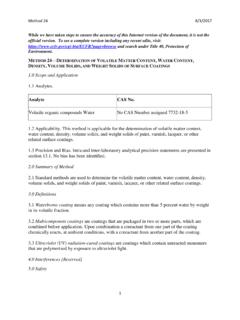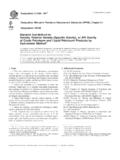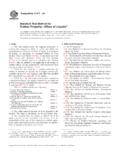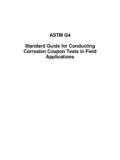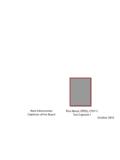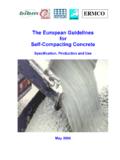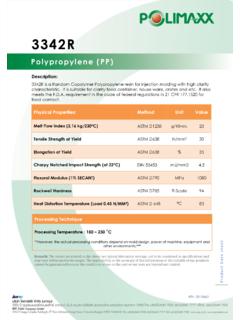Transcription of Standard Test Method for Vehicle Crash Testing of ...
1 Designation: F 2656 07 Standard Test Method forVehicle Crash Testing of perimeter barriers1 This Standard is issued under the fixed designation F 2656; the number immediately following the designation indicates the year oforiginal adoption or, in the case of revision, the year of last revision. A number in parentheses indicates the year of last reapproval. Asuperscript epsilon (e) indicates an editorial change since the last revision or perimeter barrier test methods were first published in 1985 by the Bureau of DiplomaticSecurity to assess the Crash performance of perimeter barriers and gates. Since that time, the frequencyand scale of attacks using vehicles with or without an explosive payload have increased bothinternationally and domestically. Therefore, there is a need to address a broad spectrum of possibleincident conditions such as credible threat Vehicle types for the locale, attack velocities of the differentvehicles, and different acceptable penetration limitations.
2 Also, there are different evaluation criteriafor different agencies that fulfill their unique access control operations, aesthetics, and otherorganizational requirements. This test Method is intended to expand the current Department of State,Bureau of Diplomatic Security s Crash Testing Standard to meet the broader needs of multipleorganizations responsible for the protection of assets domestically and test standards for perimeter security devices have previously been maintained by the Department, Bureau of Diplomatic Security. The Specification for Vehicle Crash Test ofPerimeter Barriers and Gates was first published in 1985 In that Standard , the testvehicle was specified as a medium-duty truck weighing 6800 kg (15 000 lb). The payload was to besecurely attached to the frame and nominal impact velocities were 50 km/h (30 mph), 65 km/h (40mph), and 80 km/h (50 mph).
3 Penetration limits were1m(3ft), 6 m (20 ft), and 15 m (50 ft) and weremeasured from the attack face of the perimeter security device to the final resting position of the frontof the frame rails of the test 2003, the State Department, Bureau of Diplomatic Security issued an updated Standard ( , Revision A) for the Testing of perimeter barriers. This update was done for severalreasons. The foremost reason for change was limited setback distances precluded the use of anydevices at their facilities or compounds that did not meet the highest test level, that is, those allowingmore than 1-m (3-ft) penetration distance. Therefore, the revised Standard only uses a 1-m (3-ft)penetration distance. Secondly, the Method of rigid attachment of the ballast to the test Vehicle was notsimulating likely payload configurations and was altering the structural integrity of the test , the updated Standard requires a payload consisting of 208-L (55-gal) steel drumsstrapped together that have been filled with soil.
4 This assembly is then strapped to the Vehicle loadplatform. The third reason for change was based on the observation that the cargo bed of trucks couldeffectively penetrate certain types of barriers. Accordingly, the penetration distance is now measuredfrom the inside face or non-impact surface of the barrier to the front of the cargo bed when the vehiclehas reached its final position. Lastly, it was determined that the trucks used different platforms withina given class affecting result consistency. The revised test Standard now requires the use of veryspecific diesel-powered medium-duty This test Method provides a range of Vehicle impactconditions, designations, and penetration performance will allow an agency to select passive perimeter barriersand active entry point barriers appropriate for use at facilitieswith a defined moving Vehicle threat.
5 Agencies may adopt andspecify those condition designations and performance levels inthis test Method that satisfy their specific needs. Agencies mayalso assign certification ratings for active and passive perimeterbarriers based on the tests and test methodologies describedherein. Many test parameters are standardized to arrive at a1 This test Method is under the jurisdiction of ASTM Committee F12 on SecuritySystems and Equipment and is the direct responsibility of Subcommittee onSystems Products and edition approved Aug. 1, 2007. Published August ASTM International, 100 Barr Harbor Drive, PO Box C700, West Conshohocken, PA 19428-2959, United Vehicle type and mass, enhance test realism andreplication, and produce uniform rating Compliance with these test procedures establishes ameasure of performance but does not render any perimeterbarrier invulnerable to Vehicle penetration.
6 Caution should beexercised in interpreting test findings and in extrapolatingresults to other than test conditions. While computer simula-tions are powerful tools that are useful in the development ofnew and improved barriers or in estimating performance underdiffering conditions, use of only the results from computersimulation for fielding a product is strongly discouraged. Whenperforming a test, developers and users are encouraged toaddress specific or unusual site conditions as needed. Oftenlocal terrain features, soil conditions, climate, or other itemswill dictate special needs at specific locations. Therefore, if siteconditions are likely to degrade a barrier s performance, theagency in need of a perimeter barrier should require testingwith the specific site conditions replicated for full-scale Product/design certification under this test Method onlyaddresses the ability of the barrier to withstand the impact ofthe test Vehicle .
7 It does not represent an endorsement of theproduct/design or address its operational The values in SI units are to be regarded as the values shown in parentheses are for information Standard does not purport to address all of thesafety concerns, if any, associated with its use. It is theresponsibility of the user of this Standard to establish appro-priate safety and health practices and to determine theapplicability of regulatory limitations prior to Referenced Standards:2D 1556 Test Method for Density and Unit Weight of Soil inPlace by the Sand-Cone MethodD 2922 Test methods for Density of Soil and Soil-Aggregate in Place by Nuclear methods (Shallow Depth) Standards4M147-65 Standard Specifications for Transportation Mate-rials and methods of Sampling and Testing , Table 1 Grading Requirements for Soil-Aggregate Materials,Grading BT099 Standard Method of Test for Moisture-Density Rela-tions of Soils Using a ( ) Rammer and a305-mm (12-in.)
8 Standard5 ISO/IEC 17025 General requirements for the competence oftesting and calibration Standard6J211-1 Instrumentation for Impact Test Part 1: ElectronicInstrumentationJ211-2 Instrumentation for Impact Test Part 2: Photo-graphic Army Corps of Engineers PDC Standard7 DOD Certified Anti-Ram Vehicle Department of State for Vehicle Crash Test of Pe-rimeter Barriers and Gates, , Revision ATest Method for Vehicle CrashTesting of perimeter Barriers and Gates, 20033. A pillar,n structural member forming the forwardcorner of the cab or passenger independent Testing laboratory,n testinglaboratory accredited to perform the referenced Testing proce-dures by a nationally recognized accrediting agency in accor-dance withISO/IEC 17025and led by a test Accredited independent Testing labora-tories may have no financial interest in or otherwise beaffiliated with companies or individuals for which they performaccreditation Testing .
9 Hereinafter, accredited independent test-ing laboratories are referred to as either accredited facilities ortesting laboratories. Other independent Testing agencies ac-tively pursuing accreditation and whose Testing protocols areaccepted by a federal agency may also conduct tests for aperiod of one year after performing the first test using this ,n specifier, responsible party, or ,n mounded section of available material suchas soil, gravel, rock, and so ,n vertical posts or series of posts, usuallysteel, concrete, wood, or combinations of same, used tochannel or restrict vehicular traffic which includes fixed,removable, and operable/retractable designation,n relates Vehicle type andvehicle velocity to the kinetic energy for which Testing barrier,n any perimeter barrier thatrelies on a continuous foundation or a continuous structuralelement to resist penetration by.
10 N post-impact barrier and Vehicle compo-nents disbursed due to ,n excavation into existing grade with varyingcross sections such as V or U referenced ASTM standards, visit the ASTM website, , orcontact ASTM Customer Service at ForAnnual Book of ASTMS tandardsvolume information, refer to the Standard s Document Summary page onthe ASTM from American Association of State Highway and TransportationOfficials (AASHTO), 444 N. Capitol St., NW, Suite 249, Washington, DC 20001, from International Organization for Standardization (ISO), 1 rue deVaremb , Case postale 56, CH-1211, Geneva 20, Switzerland, from Society of Automotive Engineers (SAE), 400 CommonwealthDr., Warrendale, PA 15096-0001, from the Army Corps of Engineers, Protective Design Center,12565 W. Center Rd., Omaha, NE 68144-3869, Maintains 1985 list for penetration barriers meet the certification criteria , Revision A,dated March 2003, with the exception of penetration, which has been evaluated forconformance , April 1985 (the previous version of the DOStesting criteria).



